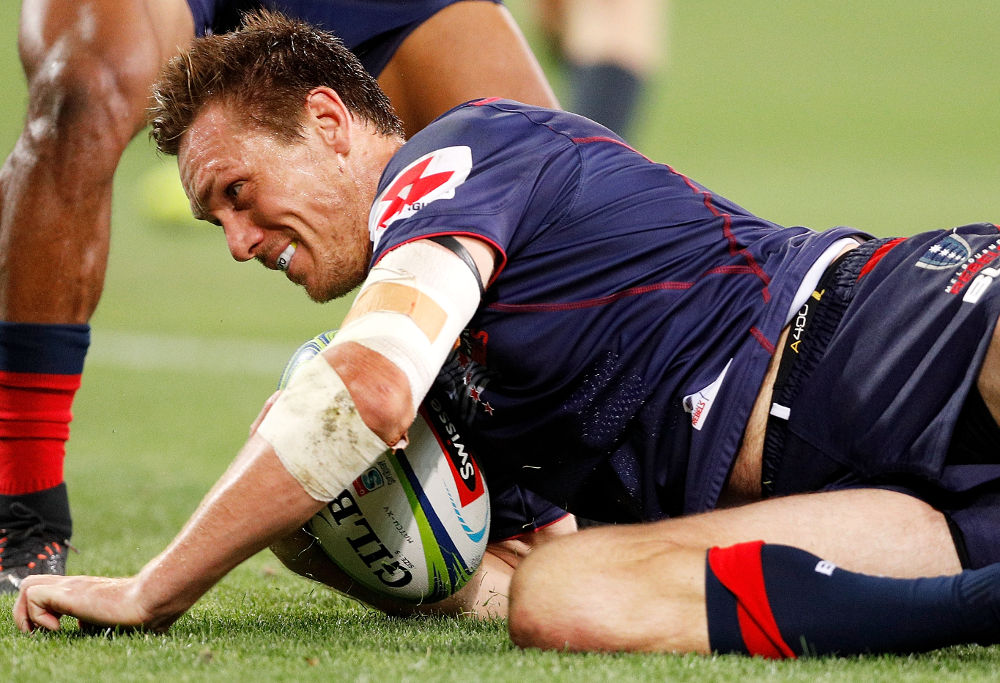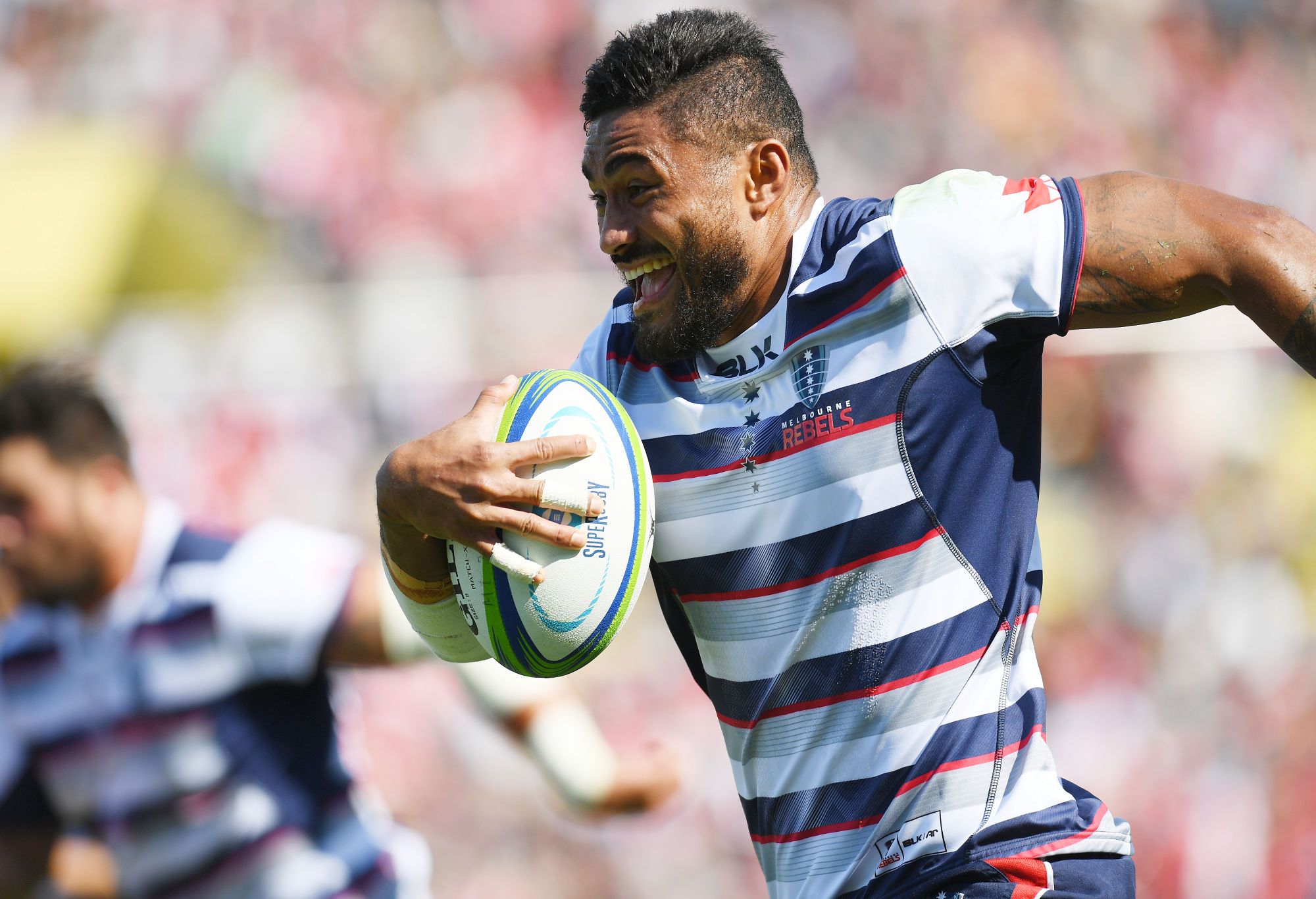It’s funny how it happens. A moment takes place in a game which might stand out at the time, or you might come to realise its significance a little later on.
But the result is the same; the moment registers in your subconscious as the difference between two teams in a contest.
This one moment that’s stuck with me from the weekend has bigger implications than just from the Rebels-Brumbies game on Friday night, however.
With the Reds still firmly in the work-in-progress ‘project’ category that Brad Thorn referred to on Saturday night, and the Waratahs in a proper state of flux that probably isn’t truly captured by their current 1-1-1 record, this one moment properly envelopes the ups and the downs of the four Australian sides after Round 4.
This was that moment.
67th minute. The Melbourne Rebels led 21-10, with Reece Hodge having just scored in the corner a few minutes earlier, following Brumbies replacement prop Les Leulua’iali’i-Makin being sent to the sin bin. The Brumbies were back on attack in the Rebels half, where they had spent most of the second half to that point, but Henry Speight’s 55th minute try was all they had to show for it.

(AAP Image/Julian Smith)
Scrumhalf Matt Lucas passed from the base of a ruck on the Rebels ten-metre line, around 25 metres in from the left-hand touch line. His pass found replacement hooker Folau Fainga’a, and he in turn looked outward to fire a pass at barnstorming number 8, Isi Naisarani. But the pass hit Naisarani’s left shoulder and flew backwards, into a no-man’s land behind Naisarani but in front of the trailing Wharenui Hawera, and with Fainga’a and Lucas both tracking in from the left, too. The four Brumbies are all closer than three Rebels defenders.
Fainga’a actually regathered the ball on the ricochet, but then threw a rushed pass to Hawera on his outside, who was promptly monstered by Marika Koroibete; the Wallabies winger seeing exactly what was happening and timing his shot perfectly. The ball spilled loose, and it was 50-50 if Tom Cusack or Rebels’ skipper Tom English were closer.
Regardless, it bounced English’s way, though he attempted to hack the ball downfield in the manner of Rebels’ teams of the past – it seemed like a good idea, but there was no real plan to it.
The ball deflects left off Cusack’s leg and straight into the arms of replacement prop Sam Talakai, who immediately promotes to lock Ross Haylett-Petty, who was well covered by Naisarani and Hawera, now back on his feet. Outside Haylett-Petty is at least four Rebels – two now with their arms out – plus Brumbies centre Kyle Godwin still on the ground among them.

(Photo by Daniel Pockett/Getty Images)
The ball finds Amanaki Mafi across the face of Richard Hardwick, and already Matt Philip and Hodge are calling for the ball. There’s at least three other Rebels now presenting on either side as options and there’s really no Brumbies defenders in the frame.
Mafi comes to one of the Arnold twins, but fires a no-look flick pass out the back before contact; he has literally no idea where the ball has gone, or who is there to get it. Philip and Hodge are in motion, and Jack Maddocks is now on their outside.
The ball bounced a metre in front of Philip, but then fortuitously up for Maddocks who is immediately looking up and eyeing off what to do next. Philip and Hodge remain on his inside, and I can count another six Rebels players trailing in midfield, and only four Brumbies, none of whom are anywhere near Maddocks.
Maddocks is quickly over halfway and is off, not to encounter a Brumbies cover defender until Lucas intercepts his path on the Brumbies’ 22-metre line. Maddocks puts a bog-standard in-and-away on Lucas and runs to the try line to score. But he’s not quite done, and casually runs it around to score behind the posts. There isn’t a Brumby in sight.
From Lucas’ pass to Talakai’s pass off the ground to Haylett-Petty, seven seconds elapsed. It took another six seconds for Maddocks to cross halfway in space, and another ten seconds had passed by the time he got the ball down. By my count, less than twenty seconds from turnover caused by their defence in their own half to Maddocks scoring at the other end.
For the last hour of the match, ‘intensity’ was a common theme throughout our ABC Grandstand radio call of the game. After Maddocks scored, I recalled a discussion with a Brumbies’ coach last season in which I’d been told they identified that, on average, New Zealand sides were scoring tries around twenty to thirty seconds from turnovers.
On average. By the same measure, at the same point in the season, Australian sides were taking upwards of a minute and though the Brumbies weren’t the worst, they weren’t the best either. The Rebels had just done exactly what Australian fans have been crying out for; converted a turnover into points in Kiwi-time.

Amanaki Mafi (Photo by Atsushi Tomura/Getty Images)
Co-commentator, former Brumbies and Wallabies centre Pat McCabe, elaborated and added that the Rebels’ line speed and defensive pressure meant the Rebels were, “playing very much like a New Zealand side”.
And that wasn’t the last time they did it, either. Only four minutes later, Hardwick picked up a loose ball from the back of a Brumbies ruck that had fallen apart and scooted away before finding Michael Ruru.
Throughout the game, when nothing was happening for the Brumbies, the Rebels were able to create opportunities for themselves all from their defensive pressure. Sometimes, like Hardwick’s turnover, sheer luck played a part. But you can create your own luck, too. Other times, like Koroibete’s hit on Hawera, the opportunity came from pure and simple hard work.
The result is the same though: just when we’ve been crying out for Australian sides to ‘be more like the Kiwis’, the Rebels look the most like a side capable of that.
[latest_videos_strip category=“rugby” name=“Rugby”]
Along with the defensive pressure though, the Rebels’ speed and intensity is a clear point of difference among the Australian teams. They don’t need ball to find points, and don’t necessarily need territory. They won 33-10 on Friday night despite playing most of the second half at their end of the ground, and they only had 42 per cent of possession for the game.
Speed and intensity are the goals in 2018. Everyone without it wants it. The Lions have it, and the Blues showed it in snaring their late win at Ellis Park. The Stormers started the season with it. The Jaguares found it Sunday morning, but mainly because the Waratahs handed it to them on a platter.
Speed and intensity created that 67th minute play for the Rebels on Friday, and it showed us everything we need to know about the Aussie conference currently. No other Australian side can boast the speed and intensity the Rebels are already playing with, just three games in.
You haven’t had to look hard for reasons not to watch Australian sides in the last season or two, but now, just maybe, the Rebels are already giving us reasons to tune back in.
































































































